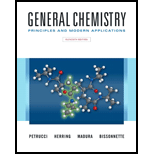
Concept explainers
(a)
Interpretation:
The sketch of
Concept introduction:
Hybridization is the mixing of orbitals. The mixing of atomic orbitals leads to the formation of hybrid orbitals. The orbitals that are not involved in bonding and are present at the ground state is known as unhybridized orbitals. The bonding orbitals are known as hybrid orbitals.
(b)
Interpretation:
The sketch of
Concept introduction:
Hybridization is the mixing of orbitals. The mixing of atomic orbitals leads to the formation of hybrid orbitals. The orbitals that are not involved in bonding and are present at the ground state is known as unhybridized orbitals. The bonding orbitals are known as hybrid orbitals.
(c)
Interpretation:
The sketch of
Concept introduction:
Hybridization is the mixing of orbitals. The mixing of atomic orbitals leads to the formation of hybrid orbitals. The orbitals that are not involved in bonding and are present at the ground state is known as unhybridized orbitals. The bonding orbitals are known as hybrid orbitals.
Want to see the full answer?
Check out a sample textbook solution
Chapter 26 Solutions
GENERAL CHEMISTRY-MOD.MASTERINGCHEM.
- make the resonance forms of benzene, cyclobutadiene, and cyclooctatetraene, showingall the carbon and hydrogen atoms.(b) Assuming that these molecules are all planar, show how the p orbitals on the sp2 hybridcarbon atoms form continuous rings of overlapping orbitals above and below the planeof the carbon atoms.arrow_forwardall of the orbital overlaps in NCO ‒---- Which of the following statements is TRUE? Select one: Pi bonds are stronger than sigma bonds. The sp2 hybridization scheme for carbon allows for the formation of two pi bonds. A carbon-carbon triple bond consists of one π bond. Pi bonds can hold 4 electrons: 2 above the bond axis, and 2 below the bond axis. A molecule with the VSEPR class AX4E2 will have a central atom that is sp3d2 hybridized.arrow_forward1.Complete the structure for anthracene, C14H10, by adding bonds and hydrogen atoms as necessary. 2.What type of hybrid orbitals are utilized by carbon in anthracene? 3. How many σ bonds and π bonds are there in an anthracene molecule? 4.How many valence electrons occupy σ‑bond orbitals, and how many occupy π‑bond orbitals?arrow_forward
- What kind of hybridization do you expect for each carbon atom in the following molecules? (a) Propane, CH3CH2CH3 (b) 2-Methylpropene, (c) But-l-en-3-yne, H2C=CHa€"Ca%ojCH (d) Acetic acid,arrow_forwardSection 7.3 shows that the compound 2-butene exists intwo isomeric forms, which can be interconverted only bybreaking a bond (in that case, the central double bond).How many possible isomers correspond to each of the following chemical formulas? Remember that a simple rotation of an entire molecule does not give a different isomer.Each molecule contains a central CuC bond.(a) C2H2Br2(b) C2H2BrCl(c) C2HBrClFarrow_forwardWhat is the hybridization on carbon in benzene?sp sp2 sp3 sp3darrow_forward
- Which of the following statements is FALSE? The boron atom of BF3 is sp2-hybridized. An atom that is sp-hybridized must be involved in a triple bond. The nitrogen atom of NF3 is sp3-hybridized. The orbitals of an sp2-hybridized atom are located 120° to one another. The carbon atoms of benzene (C6H6) are sp²-hybridized.arrow_forwardWhat is the hybridization of the sigma bonding orbitals of the carbon atom?arrow_forwardTwo isomers share the molecular formula C3H4. In Structure A two ofthe carbon atoms are sp hybridized and one carbon atom is sp3 hybridized. In Structure B, two of the carbon atoms are sp2 hybridized and one carbon atom is sphybridized. b)Draw “3D”-looking structures on paper, make a sketch of each of the isomers. (This should be a sketch of themolecules, not diagrams of overlapping orbitals!) Your drawing should show thecorrect molecular geometry around each carbon atom. [HINT: NEITHER of thesemolecules is planar!!! To draw them correctly, you will have to consider why!]arrow_forward
- What is the molecular geometry of SOCl2?arrow_forwardIndicate the hybridization of each of the carbon atoms in the structure below.arrow_forwardConsider the following molecule: a) What is the molecular formula of this substance? b) How many atoms with sp3 and sp2 hybridization does the substance have? c) Indicate in the structure the organic functions present. d) How many primary, secondary, tertiary and quaternary carbons?arrow_forward
 Chemistry: The Molecular ScienceChemistryISBN:9781285199047Author:John W. Moore, Conrad L. StanitskiPublisher:Cengage Learning
Chemistry: The Molecular ScienceChemistryISBN:9781285199047Author:John W. Moore, Conrad L. StanitskiPublisher:Cengage Learning
